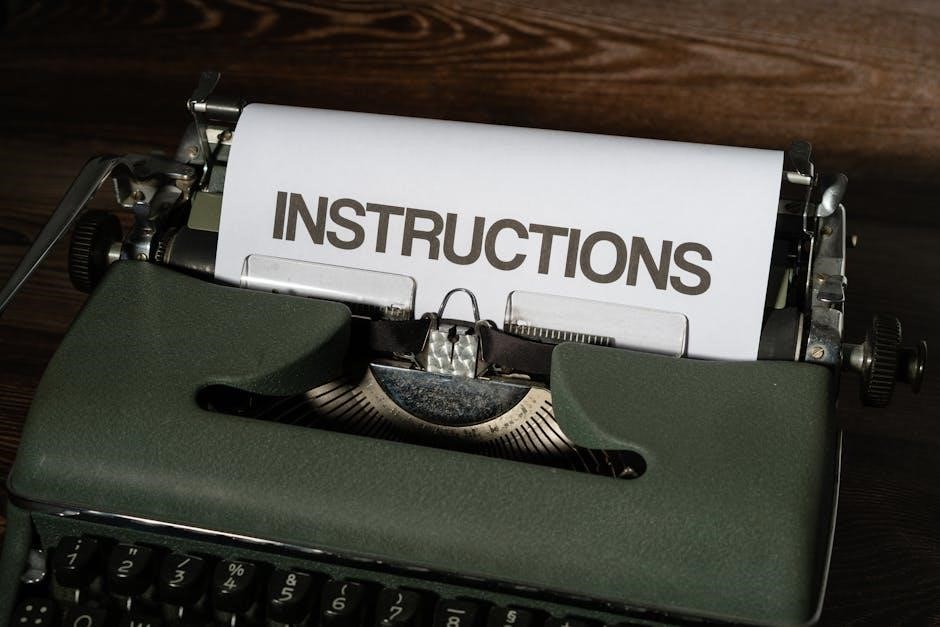Print manuals are essential guides providing detailed instructions for operating devices, software, and systems. They simplify complex information, ensuring clarity and ease of use for users. These documents are crucial for manufacturers to communicate product functionality, safety protocols, and maintenance procedures. Their design emphasizes readability, making them accessible to a wide audience. Print manuals remain indispensable in various industries, from technology to machinery, offering a reliable source of knowledge.
1.1 Definition and Purpose
A print manual is a documented guide providing detailed instructions for the operation, maintenance, and troubleshooting of a product, device, or system. Its primary purpose is to assist users in understanding how to use, configure, and resolve issues with the item effectively. Print manuals are designed to be clear and concise, offering step-by-step guidance to ensure users can navigate complex features safely and efficiently. They often include technical specifications, safety precautions, and warranty information, serving as a critical resource for both novice and experienced users. By bridging the gap between manufacturer and end-user, print manuals play a vital role in enhancing user experience and ensuring products are used as intended.
1.2 Evolution Over Time
Print manuals have undergone significant evolution, adapting to technological advancements and changing user needs. Originally, they were simple text-based documents focused on basic instructions. Over time, they incorporated visual aids like diagrams and images to enhance clarity. The rise of digital tools led to the creation of interactive manuals, combining print with QR codes linking to videos or online guides. Modern print manuals often include troubleshooting sections and maintenance schedules, reflecting a shift toward user-centric design. This evolution ensures manuals remain relevant, providing comprehensive support for increasingly complex products. By integrating traditional print with digital supplements, manuals now offer a hybrid approach, catering to diverse learning preferences and improving overall user satisfaction.

Types of Print Manuals
Print manuals come in various types, including user manuals for consumers and technical manuals for professionals. They cater to different audiences, ensuring clear guidance and detailed instructions always.
2.1 User Manuals
User manuals are designed to guide end-users in understanding and operating devices, software, or equipment. They provide step-by-step instructions, explaining features, settings, and troubleshooting tips. These manuals are often written in clear, accessible language to ensure usability for a broad audience. They typically include diagrams, illustrations, or screenshots to enhance comprehension. User manuals are essential for helping consumers make the most of their purchases, reducing confusion and frustration. For example, printer manuals detail how to load paper, connect devices, and resolve common issues like paper jams. They serve as a primary resource for users to independently manage and maintain their products effectively, ensuring a seamless experience from setup to daily use.
2.2 Technical and Training Manuals
Technical and training manuals are specialized documents designed for professionals, offering in-depth information on complex systems, machinery, or software. These manuals are often used in industrial, engineering, or IT settings, providing detailed technical specifications, operational procedures, and advanced troubleshooting techniques. They are essential for training personnel, ensuring they can perform tasks safely and efficiently. For instance, technical manuals for printers might include diagnostic procedures, maintenance schedules, and repair guidelines. Training manuals, on the other hand, focus on teaching users how to master specific skills or software, such as programming languages like Python or tools like curl. These manuals are tailored to meet the needs of experts and learners alike, fostering proficiency and problem-solving capabilities in specialized fields.
Importance of Print Manuals
Print manuals are vital for ensuring user understanding and manufacturer support. They provide clear instructions, troubleshooting guides, and safety protocols, making them indispensable for effective product use and maintenance.
3.1 Essential for User Understanding
Print manuals are crucial for ensuring users grasp how to operate devices, software, or systems effectively. They provide clear, step-by-step instructions, breaking down complex processes into understandable language. Clarity is key, as manuals eliminate confusion by detailing features, functions, and safety precautions. Visual aids like diagrams and illustrations further enhance comprehension. For novices, print manuals serve as a foundational guide, while experienced users rely on them for troubleshooting or advanced operations. Their structured format ensures users can navigate information effortlessly, making them an indispensable resource for mastering any product or technology.
3.2 Critical for Manufacturer Support
Print manuals are vital for manufacturers to provide effective support to their customers. They serve as a primary resource for troubleshooting common issues, ensuring users can resolve problems independently. Manuals often include detailed error codes, diagnostic procedures, and repair guidelines, reducing the need for direct manufacturer intervention. Additionally, they provide clear instructions for maintenance, enhancing product longevity; Manufacturers rely on these documents to communicate critical safety information and compliance requirements. By including contact details and support options, print manuals act as a bridge between users and manufacturers, fostering trust and satisfaction. They also help manufacturers maintain legal compliance by outlining proper usage and liability disclaimers, protecting both parties.

Key Components of a Print Manual
A print manual typically includes essential sections like an introduction, technical specifications, safety guidelines, and operational procedures. It often features visual aids, diagrams, and an index for easy navigation. These components ensure clarity and accessibility, making the manual a comprehensive resource for users.
4.1 Table of Contents and Index
A well-structured print manual begins with a clear table of contents, guiding users through the document’s organization. This section lists all major chapters and subsections, ensuring easy navigation. The index, located at the end, provides quick access to specific topics or keywords, enhancing usability. Together, these elements save time by allowing users to locate information efficiently. A detailed table of contents helps readers understand the manual’s flow, while the index caters to those seeking specific details. Both components are essential for readability and accessibility, making the manual user-friendly even for complex subjects. Proper indexing and tabulation ensure that users can swiftly find the information they need, improving overall comprehension and satisfaction.
4.2 Troubleshooting Guide
A troubleshooting guide is a critical component of print manuals, addressing common issues users may encounter. It provides step-by-step solutions for resolving problems, such as paper jams, connectivity errors, or print quality issues. This section often includes FAQs, error codes, and diagnostic procedures to help users identify and fix problems independently. Clear instructions and visual aids, like diagrams, enhance understanding. By offering practical advice, the troubleshooting guide reduces frustration and downtime, ensuring users can quickly resume their tasks. It also serves as a reference for manufacturers to address recurring issues in future updates. A well-organized troubleshooting guide is indispensable for maintaining user satisfaction and operational efficiency;

Design and Layout Considerations
Effective design and layout ensure print manuals are visually appealing and easy to navigate. Clear typography, proper spacing, and logical organization enhance readability and user comprehension. Visual elements like diagrams and flowcharts simplify complex information, making it accessible to all users. Consistent formatting and intuitive structure help users quickly locate information, improving overall efficiency. Attention to detail in design ensures the manual remains professional and aligned with brand standards, fostering trust and reliability.
5.1 Layout and Structure
A well-organized layout and structure are vital for print manuals to ensure clarity and ease of use. The manual should begin with a clear table of contents, allowing users to navigate seamlessly through sections. Headings and subheadings should be distinct, guiding readers through logical steps. Proper typography, spacing, and alignment are essential to avoid clutter and enhance readability. Visual elements like diagrams, flowcharts, and images should be strategically placed to complement text, making complex information easier to understand. Margins and white space should be ample to prevent overcrowding, while consistent formatting ensures a professional appearance. An intuitive structure, with clear section divisions, enables users to locate information quickly, improving overall efficiency and satisfaction.
5.2 Typography and Readability
Typography and readability are critical in print manuals to ensure information is easily understandable. Font size and style should be chosen for clarity, with sans-serif fonts often recommended for printed materials. Consistent font sizes throughout the manual maintain a professional appearance and prevent visual confusion. Line spacing and paragraph formatting should be optimized to avoid overcrowding, making the text more approachable. The use of bold or italic text can highlight important terms or steps without disrupting the flow. Avoid overly complex fonts that may hinder readability, especially for users with visual impairments. Proper contrast between text and background ensures visibility, while clear typography enhances the overall usability of the manual for diverse audiences.

Technical Aspects of Printing
Technical aspects of printing involve selecting the right paper quality, ink, and binding methods to ensure durability and readability. Proper material choices enhance the manual’s longevity and usability.
6.1 Paper Quality and Ink Selection
High-quality paper ensures durability and readability, while appropriate ink selection enhances text clarity. Brightness levels (80-100 ISO) are crucial for readability, with heavier paper (70-80 gsm) offering better durability.
Ink choice depends on the manual’s purpose—dye-based for vibrant colors and pigment-based for longevity. Water-resistant ink is ideal for manuals exposed to moisture.
Proper paper and ink pairing prevents smudging and fading, ensuring the manual remains legible over time. These choices also affect environmental impact, with recycled options gaining popularity.
Balancing cost, quality, and environmental factors is key to producing effective print manuals.
6.2 Binding Methods
Binding methods are crucial for ensuring print manuals are durable and user-friendly. Common techniques include perfect binding, saddle stitching, spiral binding, and hardcover binding.
Perfect binding uses glue to attach pages to a cover, ideal for thick manuals. Saddle stitching involves stapling pages together along the spine, suitable for thinner documents.
Spiral binding allows pages to rotate 360 degrees, making it easy to flip through sections. Hardcover binding offers maximum durability, often used for high-value or long-lasting manuals.
Choosing the right method depends on the manual’s thickness, intended use, and budget. Proper binding ensures the manual remains intact over time, providing easy access to information.

Challenges in Creating Print Manuals
Creating print manuals involves overcoming readability issues, ensuring clarity, and addressing translation challenges. Small font sizes and complex layouts can hinder understanding, while localization demands precise cultural adaptation.
7.1 Readability Issues
Readability issues in print manuals often stem from poor design choices, such as small font sizes, which can make text difficult to read. Many users have reported that manuals printed in certain regions, like India, use font sizes as small as 4 or 6 points, rendering the text nearly illegible. Additionally, complex layouts and dense paragraphs can overwhelm readers, especially those with visual impairments. Technical jargon and lack of clear explanations further exacerbate the problem, making it hard for non-experts to understand instructions. To address this, manual creators must prioritize clear typography, concise language, and logical organization of content. Ensuring readability is crucial for making manuals accessible and user-friendly for all audiences.
7.2 Translation and Localization
Translation and localization challenges arise when print manuals are adapted for global audiences. Ensuring accuracy in language translation while maintaining technical integrity is critical. Cultural differences and regional regulations often require adjustments to content, which can be complex. For instance, manuals must comply with local laws and standards, adding layers of complexity. Poor translations or misaligned content can lead to confusion, safety hazards, or non-compliance. Additionally, formatting issues, such as text expansion or contraction in different languages, can affect layout and readability. Addressing these challenges requires collaboration between translators, cultural experts, and technical writers to ensure manuals remain clear, accurate, and relevant across diverse markets. Effective localization ensures that users worldwide can understand and apply the information effectively.

Solutions to Common Print Manual Issues
Implementing digital supplements and clear instructional language enhances print manual effectiveness. These solutions address readability, comprehension, and accessibility, ensuring users can efficiently utilize the information provided.
8.1 Digital Supplements
Digital supplements enhance print manuals by providing additional resources and interactive content. These can include QR codes linking to videos, downloadable PDFs, or online guides. Supplements like digital versions of manuals ensure users can access information anytime, reducing reliance on physical copies. They also allow for real-time updates, keeping content current and accurate. Interactive features, such as searchable indexes and hyperlinks, improve navigation. Digital supplements are particularly useful for complex manuals, offering in-depth details without cluttering the print version. They also enable manufacturers to provide multilingual support easily. Overall, digital supplements modernize print manuals, making them more versatile and user-friendly while addressing practical challenges like storage and accessibility.
8.2 Clear Instructional Language
Clear instructional language is vital for ensuring print manuals are understandable and effective. Using simple, direct language avoids confusion and ensures users can follow instructions without ambiguity. Avoiding jargon and complex sentences makes manuals accessible to a broader audience. Proper punctuation, consistent terminology, and logical sequencing of steps enhance clarity. Bullet points and numbered lists can break down complex processes, improving readability. Clear language also reduces errors, as users are less likely to misinterpret instructions. This is especially critical in technical or safety-critical contexts. By prioritizing clear communication, print manuals become more user-friendly and reliable, ensuring that the intended information is conveyed effectively to all readers;

Best Practices for Effective Print Manuals
Effective print manuals prioritize clarity, conciseness, and user-centric design. Use clear language, visuals, and logical organization to enhance understanding. Incorporate feedback mechanisms to improve future editions and ensure accuracy. Consistency in formatting and terminology is key. Regular updates maintain relevance, addressing evolving user needs and technological advancements. These practices ensure manuals remain indispensable resources for users.
9.1 Use of Visual Aids
Visual aids are crucial for enhancing the effectiveness of print manuals. Images, diagrams, and charts help users understand complex concepts quickly. They break down intricate steps into digestible visuals, reducing confusion. High-quality visuals ensure clarity, even for those with limited technical knowledge. Consistency in style and labeling avoids confusion. Visuals also complement textual instructions, making manuals more engaging. Properly sized images prevent overcrowding, ensuring readability. Cross-referencing visuals with text improves comprehension. For technical topics, screenshots or schematics are invaluable. Visual aids cater to diverse learning styles, making manuals accessible to a broader audience. Regularly updating visuals keeps them relevant and aligned with product evolution. This approach ensures manuals remain user-friendly and effective communication tools.
9.2 Feedback Mechanisms

Feedback mechanisms in print manuals enable users to provide input, enhancing future editions. Surveys, QR codes, and email addresses are common tools for gathering opinions. Manufacturers can identify areas for improvement, such as unclear instructions or missing information, through user feedback. This ensures manuals remain relevant and user-friendly. Regular updates based on feedback improve accuracy and clarity, addressing common issues. Feedback loops help manufacturers refine content, ensuring it meets user needs. This iterative process fosters trust and satisfaction, making print manuals indispensable resources. By incorporating feedback, manuals evolve to better serve their audience, maintaining their value in an ever-changing environment. Effective feedback mechanisms are vital for continuous improvement and user engagement.

Future Trends in Print Manual Creation
Future trends in print manual creation include digital integration, AI-driven content generation, and interactive QR codes linking to video tutorials. Sustainability and personalized printing will also rise.
10.1 Digital Integration
Digital integration is revolutionizing print manuals by combining physical and digital content seamlessly. QR codes embedded in manuals link to video tutorials, enhancing user understanding. Interactive PDFs allow users to navigate easily between sections, while digital supplements provide real-time updates. This fusion ensures manuals remain relevant in a tech-driven world, offering convenience and accessibility. Digital integration also enables multilingual support, catering to global audiences. Manufacturers can now incorporate dynamic content, such as animations and 3D models, to simplify complex instructions. This trend bridges the gap between traditional print and modern digital preferences, creating a hybrid solution that meets diverse user needs. As technology evolves, digital integration will continue to enhance the functionality and user experience of print manuals.
10.2 AI and Automation
AI and automation are transforming the creation and maintenance of print manuals, enhancing efficiency and accuracy. AI-powered tools generate customized content, personalize instructions, and automate updates, reducing manual effort. Automated workflows streamline the printing process, minimizing errors and ensuring consistency. These technologies enable real-time adjustments, such as translating manuals into multiple languages or adapting content based on user feedback. AI-driven analytics can also predict common issues, allowing manufacturers to proactively improve manual clarity. Automation further optimizes paper usage and ink selection, reducing production costs. By integrating AI, print manuals become smarter, more accessible, and aligned with modern user needs. This technology ensures manuals remain a vital resource in an increasingly digital world, bridging tradition with innovation.
